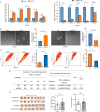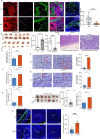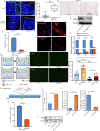ASCL2 induces an immune excluded microenvironment by activating cancer-associated fibroblasts in microsatellite stable colorectal cancer
- PMID: 37591954
- PMCID: PMC10504082
- DOI: 10.1038/s41388-023-02806-3
ASCL2 induces an immune excluded microenvironment by activating cancer-associated fibroblasts in microsatellite stable colorectal cancer
Abstract
Proficient mismatch repair or microsatellite stable (pMMR/MSS) colorectal cancers (CRCs) are vastly outnumbered by deficient mismatch repair or microsatellite instability-high (dMMR/MSI-H) tumors and lack a response to immune checkpoint inhibitors (ICIs). In this study, we reported two distinct expression patterns of ASCL2 in pMMR/MSS and dMMR/MSI-H CRCs. ASCL2 is overexpressed in pMMR/MSS CRCs and maintains a stemness phenotype, accompanied by a lower density of tumor-infiltrating lymphocytes (TILs) than those in dMMR/MSI CRCs. In addition, coadministration of anti-PD-L1 antibodies facilitated T cell infiltration and provoked strong antitumor immunity and tumor regression in the MC38/shASCL2 mouse CRC model. Furthermore, overexpression of ASCL2 was associated with increased TGFB levels, which stimulate local Cancer-associated fibroblasts (CAFs) activation, inducing an immune-excluded microenvironment. Consistently, mice with deletion of Ascl2 specifically in the intestine (Villin-Cre+, Ascl2 flox/flox, named Ascl2 CKO) revealed fewer activated CAFs and higher proportions of infiltrating CD8+ T cells; We further intercrossed Ascl2 CKO with ApcMin/+ model suggesting that Ascl2-deficient expression in intestinal represented an immune infiltrating environment associated with a good prognosis. Together, our findings indicated ASCL2 induces an immune excluded microenvironment by activating CAFs through transcriptionally activating TGFB, and targeting ASCL2 combined with ICIs could present a therapeutic opportunity for MSS CRCs.
© 2023. The Author(s).
Conflict of interest statement
The authors declare no competing interests.
Figures







Similar articles
-
Immunotherapy efficacy on mismatch repair-deficient colorectal cancer: From bench to bedside.Biochim Biophys Acta Rev Cancer. 2020 Dec;1874(2):188447. doi: 10.1016/j.bbcan.2020.188447. Epub 2020 Oct 6. Biochim Biophys Acta Rev Cancer. 2020. PMID: 33035640 Free PMC article. Review.
-
A subset of patients with MSS/MSI-low-colorectal cancer showed increased CD8(+) TILs together with up-regulated IFN-γ.Oncol Lett. 2019 Dec;18(6):5977-5985. doi: 10.3892/ol.2019.10953. Epub 2019 Oct 2. Oncol Lett. 2019. PMID: 31788072 Free PMC article.
-
Microsatellite instability in mismatch repair proficient colorectal cancer: clinical features and underlying molecular mechanisms.EBioMedicine. 2024 May;103:105142. doi: 10.1016/j.ebiom.2024.105142. Epub 2024 Apr 30. EBioMedicine. 2024. PMID: 38691939 Free PMC article.
-
Role of the cGAS-STING pathway in regulating the tumor-immune microenvironment in dMMR/MSI colorectal cancer.Cancer Immunol Immunother. 2022 Nov;71(11):2765-2776. doi: 10.1007/s00262-022-03200-w. Epub 2022 Apr 16. Cancer Immunol Immunother. 2022. PMID: 35429245 Free PMC article.
-
Regorafenib in combination with immune checkpoint inhibitors for mismatch repair proficient (pMMR)/microsatellite stable (MSS) colorectal cancer.Cancer Treat Rev. 2022 Nov;110:102460. doi: 10.1016/j.ctrv.2022.102460. Epub 2022 Aug 27. Cancer Treat Rev. 2022. PMID: 36058142 Review.
Cited by
-
GJA4 expressed on cancer associated fibroblasts (CAFs)-A 'promoter' of the mesenchymal phenotype.Transl Oncol. 2024 Aug;46:102009. doi: 10.1016/j.tranon.2024.102009. Epub 2024 Jun 4. Transl Oncol. 2024. PMID: 38833783 Free PMC article.
-
Machine learning for identifying tumor stemness genes and developing prognostic model in gastric cancer.Aging (Albany NY). 2024 Apr 12;16(7):6455-6477. doi: 10.18632/aging.205715. Epub 2024 Apr 12. Aging (Albany NY). 2024. PMID: 38613794 Free PMC article.
-
The emerging role of intestinal stem cells in ulcerative colitis.Front Med (Lausanne). 2025 Mar 25;12:1569328. doi: 10.3389/fmed.2025.1569328. eCollection 2025. Front Med (Lausanne). 2025. PMID: 40201327 Free PMC article. Review.
-
Signature Gene Mutations in Colorectal Cancer: Potential Neoantigens for Cancer Vaccines.Int J Mol Sci. 2025 May 9;26(10):4559. doi: 10.3390/ijms26104559. Int J Mol Sci. 2025. PMID: 40429703 Free PMC article. Review.
-
Molecular and functional profiling unravels targetable vulnerabilities in colorectal cancer.Mol Oncol. 2025 Jun;19(6):1751-1774. doi: 10.1002/1878-0261.13814. Epub 2025 Jan 28. Mol Oncol. 2025. PMID: 39876058 Free PMC article.
References
-
- Diaz LA, Jr, Shiu KK, Kim TW, Jensen BV, Jensen LH, Punt C, et al. Pembrolizumab versus chemotherapy for microsatellite instability-high or mismatch repair-deficient metastatic colorectal cancer (KEYNOTE-177): final analysis of a randomised, open-label, phase 3 study. Lancet Oncol. 2022;23:659–70. doi: 10.1016/S1470-2045(22)00197-8. - DOI - PMC - PubMed
Publication types
MeSH terms
Substances
LinkOut - more resources
Full Text Sources
Medical
Molecular Biology Databases
Research Materials

